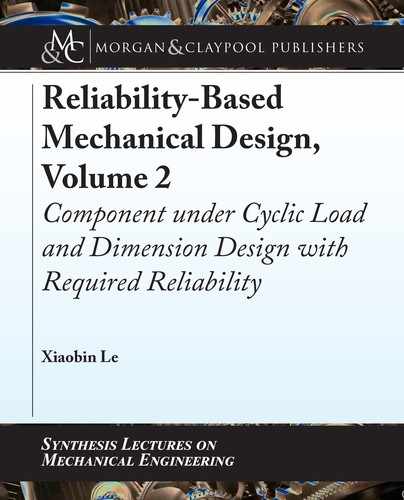
108 2. RELIABILITY OF A COMPONENT UNDER CYCLIC LOAD
In this example, the fatigue damage index D is deterministic. e reliability of the specimen
under the specified cyclic axial stress will be:
R D P
.
K
0
D
/
D P
.
ln
.
K
0
/
ln.D/
/
D ˆ
ln K
0
ln.D/
ln K
0
D ˆ
25:3014 24:65841
0:238106
D ˆ
.
2:61961
/
D 0:99560:
Both the P-S-N curves and the K-D model are probabilistic fatigue theory and can be
used to calculate the reliability of a component under cyclic loading spectrums. ere are four
distinguished features of the K-D model with comparison to the P-S-N curve approach.
1. e K-D model uses all fatigue test data under all test stress levels to conduct statistical
analysis to represent the scatters of material fatigue behavior. From the general view of
statistics, the derived distribution parameters in the K-D model are much reliable because
of the much larger sample size.
2. If sometimes, the fatigue test data of some materials are not enough to compile a practical
P-S-N curve, the data may still be used by the K-D model to describe the fatigue behaviors
and to conduct the calculation of the fatigue reliability. For example, five test data on each
of seven different constant stress levels are not enough for the P-S-N curve approach.
However, for the K-D model, the sample size is 35. erefore, the K-D model is more
practical for fatigue reliability design.
3. In the K-D model, one probabilistic distribution function is used to describe material
fatigue behavior and to conduct fatigue reliability evaluation. So, it is more convenient for
fatigue reliability evaluation.
4. e K-D model can be used to calculate the reliability of a component under any type of
cyclic loading spectrum.
2.10 SUMMARY
Fatigue failure is one of the most common and important failure modes when a metal compo-
nent is subjected to a cyclic stress spectrum. ree parameters for describing cyclic stress are
stress mean
m
, stress amplitude
a
and the number of cycles n
L
. Since the mean stress will be
mainly used to calculate the equivalent fully revered stress amplitude, stress amplitude
a
and
the number of cycles n
L
are two main parameters for describing a cyclic loading spectrum. Six
different cyclic loading spectrums have been discussed in Section 1.2 and relisted here in Ta-
ble 2.61. Any cyclic stress spectrum or cyclic loading spectrum can be described by one of these
six cyclic loading spectrums.

2.10. SUMMARY 109
Table 2.61: Six cyclic loading spectrums
Cyclic loading
spectrum model #
Number of cycles n
L
Mean stress σ
m
Stress amplitude σ
a
#1 n
L
-constant σ
m
-constant σ
a
-constant
#2 n
L
-distributed σ
m
-constant σ
a
-constant
#3
n
L
-constant
σ
m
-constant σ
a
-distributed
#4
n
Li
, i = 1,2,…, L
constants
σ
mi
, i = 1,2,…, L
constants
σ
ai
, i = 1,2,…, L
constants
#5
n
Li
, i = 1,2,…, L
distributed
σ
mi
, i = 1,2,…, L
constants
σ
ai
, i = 1,2,…, L
constants
#6
n
Li
, i = 1,2,…, L
constants
σ
mi
, i =1,2,…, L
constants
σ
ai
, i = 1,2,…, L
distributed
For a high-cycle fatigue issue, which is a common case in general engineering design,
material fatigue strength data is typically obtained through a stress-life method. In a stress-
life method, fatigue specimen is subjected to constant cyclic stress. e fatigue test result per a
fatigue test is the number of cycles at failure, that is, a fatigue life under specified constant cyclic
stress level. Both the P-S-N curve approach discussed in Section 2.8 and the K-D probabilistic
fatigue damage model discussed in Section 2.9 are fatigue theories to analyze and to represent the
fatigue test data for the calculation of reliability of component under a cyclic loading spectrum.
e P-S-N curve approach can provide two sets of distributions. One is the P-N distri-
butions, in which material fatigue life under a specified constant cyclic stress level is treated as a
random variable and described by a normal distribution or a log-normal distribution. Another
is the P-S distributions, in which material fatigue strength at a specified constant fatigue life,
is treated as a random variable and typically described by a normal distribution or a log-normal
distribution. When the P-S-N curve approach is used to calculate the reliability of a component
under a cyclic loading spectrum, we have the following conclusions.
• When a component is subjected to model #1, model #2, or model #3 cyclic loading spec-
trum, we can use the P-S-N curve to build the limit state function. erefore, the reliability
of component under such cyclic loading spectrum can be calculated by the definition of re-
liability, or the H-L, R-F, or Monte Carlo method. ese are discussed in Sections 2.8.3,
2.8.4, and 2.8.5.
• When a component is subjected to model #4, or model #5 cyclic loading spectrum, the
limit state function of a component under such cyclic loading cannot be established. How-
ever, equivalent fatigue damage concepts can be used to calculate the reliability of the
component. ese are discussed in Sections 2.8.6 and 2.8.7.
..................Content has been hidden....................
You can't read the all page of ebook, please click here login for view all page.
